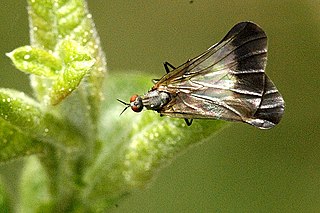
Empis is a genus of dance fly found in the fly family Empididae.

Rhamphomyia is a genus of dance flies, in the fly family Empididae. It contains more than 600 species in 8 subgenera.

Ocydromiinae is a subfamily of hybotid flies.

Brachystomatinae is a subfamily of flies belonging to the family Empididae.

Empidinae, also called dance flies, are a subfamily of empidoid flies. They are mainly predatory flies like most of their relatives, and generally small to medium-sized. Most species are flower visitors and they can be effective pollinators.
Apalocnemis is a genus of flies in the family Empididae.
Aplomera is a genus of flies in the family Empididae.
Atrichopleura is a genus of flies in the family Empididae.
Deuteragonista is a genus of flies in the family Empididae.
Hilarempis is a genus of flies in the family Empididae.
Sphicosa is a genus of flies in the family Empididae.

Chelipoda is a genus of flies in the family Empididae.
Cladodromia is a genus of flies in the family Empididae.
Neoplasta is a genus of flies in the family Empididae.

Drapetis is a genus of flies in the family Hybotidae.

Ocydromiini is a tribe of hybotid flies.
Austrodromia is a genus of flies in the family Hybotidae.





